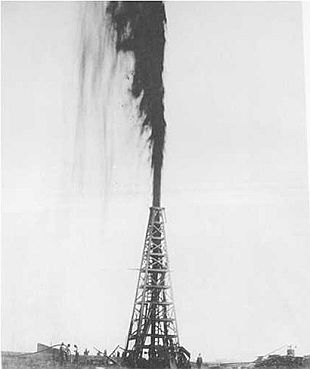Anyone who was alive and conscious in the 1980s probably remembers Dallas, the super-popular TV drama featuring the Ewings, a wealthy Texas oil family, and all the excitement and heartache that goes with that kind of money and power.
The popular culture phenomenon that created the series, however, goes back all the way to the early twentieth century — when the Lone Star State began its ascent to the top of North American oil production…
Starting in 1901 with Texas’ first famous “gusher” at the now legendary Spindletop oil field.
While the rest of the world was just starting to get used to the idea of cars replacing horses and internal combustion replacing coal-fired boilers, Spindletop quickly developed into a 100,000-barrel-per-day producer.

Then the rest of the twentieth century unfolded.
Since those first days of “black gold” and “Texas tea,” the balance of world oil power has shifted multiple times.
As the first highly-exploited major fossil fuel region in the world, Texas was also the first to peak out, relinquishing its status to places like Kuwait and Saudi Arabia.
And today that balance is shifting once again…
You’ve probably read or at least heard about North American oil making a major comeback.
Terms like ‘shale oil’ and ‘Bakken Formation’ have come to symbolize a new era of North American crude oil domination.
But what you don’t hear about nearly as often is the return of an old American icon: Texas oil.
Under our very noses, this one-time behemoth of global oil power is now on its way back.
I want you to burn a specific term into your mind, just like you may have already done with the Bakken…
That term is Eagle Ford.
It’s already well on its way to becoming the second coming of Texas’s legendary Spindletop.
Like the Bakken, Eagle Ford is a shale formation — meaning it was left completely untouched by the first massive rush of oil production, which began more than 100 years ago.
Stay on top of the hottest investment ideas before they hit Wall Street. Sign up for the Wealth Daily newsletter below. You’ll also get our free report, “A Great Year Ahead for Natural Gas: A 2017 Outlook” by our expert research team.
This virgin geological structure only recently became accessible to production using modern extraction methods.
It was already producing 60,000 barrels per day in 2011 — or about 60% of what Spindletop was producing when it became the world’s first super-oil field back at the start of the twentieth century.
Like everything in Texas, Eagle Ford is big…
At 50 miles wide and 400 miles long, the formation runs through 14 southwestern and south central counties.

And current production levels have only begun to scratch the surface of what Eagle Ford really has in store.
Geologists estimate that within a few years, Eagle Ford could be pumping out as much as 1 million barrels per day.
If that sounds like a lot, that’s because it is.
It’s more oil than the entire nation of India produces…
It’s 60% more than Egypt’s entire national production…
And when that number is achieved, it will constitute about 12% of U.S. total daily output.
Like other newly-tapped oil resources in North America, the actual oil this region will produce will only be one prong of its positive effect on the regional and national economy.
In 2011 alone, Eagle Ford created 47,000 new jobs and generated more than $25 billion in the South Texas economy.
By 2021, this mega-formation will have created 117,000 in South Texas — and shifted much of the American oil import market back to domestic production.
But again, this is still just one part of the much greater story.
Whether the topic is Eagle Ford, the Bakken, or the Marcellus Shale formation, the long-term trend here is the same: North American oil is back — and it’s back in a big way.
To your wealth,

Brian Hicks
Brian is a founding member and President of Angel Publishing. He writes about general investment strategies for Wealth Daily and Energy and Capital. Brian is the managing editor and investment director of R.I.C.H Report (Retired Independent Carefree Healthy), New World Assets and Extreme Opportunities. For more on Brian, take a look at his editor’s page.



